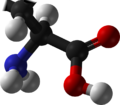| The complete data for Glutamic acid () | ||||||||||||||||
  | General information Chemical formula : C 5 H 9 N O 4 Molar mass : 147.13 g·mol−1 Systematic name : (2S)-2-aminopentanedioic acid Abbreviations : E, Glu Synonyms : 2-amino-glutaric acid Glutacid Glutaminic acid | |||||||||||||||
| Database data | ||||||||||||||||
| SMILES : OC(=O)CCC(N)C(=O)O InChI =1/C5H9NO4/c6-3(5(9)10)1-2-4(7)8/h3H,1-2,6H2,(H,7,8)(H,9,10)/t3-/m0/s1/f/h7,9H - (L)
| ||||||||||||||||
| Physical properties | ||||||||||||||||
| ||||||||||||||||
| Hazard properties | ||||||||||||||||
| ||||||||||||||||
| Chemical properties | ||||||||||||||||
| ||||||||||||||||
| Pharmacological properties | ||||||||||||||||
This box:
- Except where noted otherwise, data relate to Standard temperature and pressure.
- Reliability of data general note.
